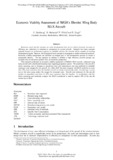JavaScript is disabled for your browser. Some features of this site may not work without it.
| dc.contributor.author | Goldberg, Chana | |
| dc.contributor.author | Nalianda, Devaiah | |
| dc.contributor.author | Pilidis, Pericles | |
| dc.contributor.author | Singh, Riti | |
| dc.date.accessioned | 2017-08-30T16:02:54Z | |
| dc.date.available | 2017-08-30T16:02:54Z | |
| dc.date.issued | 2017-07-12 | |
| dc.identifier.citation | Goldberg C, Nalianda D, Pilidis P, Singh R, Economic viability assessment of NASA’s blended wing body N3-X aircraft, Proceedings of 53rd AIAA/SAE/ASEE Joint Propulsion Conference 2017, AIAA Propulsion and Energy Forum, 10 - 12 July 2017, Atlanta, GA, USA, Paper number AIAA 2017-4604 | en_UK |
| dc.identifier.uri | http://dx.doi.org/10.2514/6.2017-4604 | |
| dc.identifier.uri | https://dspace.lib.cranfield.ac.uk/handle/1826/12409 | |
| dc.description.abstract | Numerous novel aircraft concepts are under development that aim to achieve dramatic increases in efficiency and reductions in emissions in comparison to current aircraft. Research into these concepts typically focuses on performance aspects to establish whether the aircraft will be capable of meeting developmental goals. However, the final goal of such concepts is to progress to viable commercial products. Economic viability assessments are therefore an integral part of the development process to ensure a sustainable industry. The key question to address is whether a high efficiency aircraft concept can translate into an attractive product from an economic perspective. This research performed an economic viability assessment of NASA's N3-X aircraft, a blended wing body aircraft with a distributed boundary layer ingesting propulsion system. The sensitivity of the aircraft's direct operating cost to changes in acquisition price and maintenance cost was predicted to establish maximum cost margins for the aircraft. In a May 2017 fuel price scenario, the N3-X could be no more than 25% more expensive than the baseline aircraft to remain economically viable. Introducing a carbon tax or fuel price jump widens the margin for increased costs. Aircraft cost estimates for the aircraft predict an acquisition cost from 11{37% more expensive than the baseline. In combination with the direct operating cost sensitivity analysis, the N3-X is predicted to need to capture 30% of the aircraft market up to 2035. | en_UK |
| dc.language.iso | en | en_UK |
| dc.publisher | AIAA | en_UK |
| dc.rights | ©2017 AIAA. This is the Author Accepted Manuscript. Please refer to any applicable publisher terms of use. | |
| dc.title | Economic viability assessment of NASA's blended wing body N3-X aircraft | en_UK |
| dc.type | Conference paper | en_UK |
Files in this item
This item appears in the following Collection(s)
-
Staff publications (SATM) [4365]
